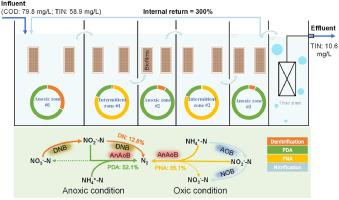当前位置:
X-MOL 学术
›
Water Res.
›
论文详情
Our official English website, www.x-mol.net, welcomes your
feedback! (Note: you will need to create a separate account there.)
Enhanced nitrogen removal via partial nitrification/denitrification coupled Anammox using three stage anoxic/oxic biofilm process with intermittent aeration
Water Research ( IF 11.4 ) Pub Date : 2024-03-19 , DOI: 10.1016/j.watres.2024.121491
Zhuang Zhang 1 , Deyong Li 1 , Changhui Zhou 1 , Xiaoshan Huang 1 , Yantong Chen 1 , Shijie Wang 1 , Guoqiang Liu 1
Water Research ( IF 11.4 ) Pub Date : 2024-03-19 , DOI: 10.1016/j.watres.2024.121491
Zhuang Zhang 1 , Deyong Li 1 , Changhui Zhou 1 , Xiaoshan Huang 1 , Yantong Chen 1 , Shijie Wang 1 , Guoqiang Liu 1
Affiliation

|
Pre-capturing organics in municipal wastewater for biogas production, combined with Anammox-based nitrogen removal process, improves the sustainability of sewage treatment. Thus, enhancing nitrogen removal via Anammox in mainstream wastewater treatment becomes very crucial. In present study, a three-stage anoxic/oxic (AO) biofilm process with intermittent aeration was designed to strengthen partial nitrification/denitrification coupling Anammox (PNA/PDA) in treatment of low C/N wastewater, which contained chemical oxygen demand (COD) of 79.8 mg/L and total inorganic nitrogen (TIN) of 58.9 mg/L. With a hydraulic retention time of 8.0 h, the process successfully reduced TIN to 10.6 mg/L, achieving a nitrogen removal efficiency of 83.3 %. The 1st anoxic zone accounted for 32.0 % TIN removal, with 10.3 % by denitrification and 21.7 % by PDA, meanwhile, the 2nd and 3rd anoxic zones contributed 19.4 % and 4.5 % of TIN removal, primarily achieved through PDA (including endogenous PD coupling Anammox). The 1st and 2nd intermittent zones accounted for 27.2 % and 17.0 % of TIN removal, respectively, with 13.7 %-21.3 % by PNA and 3.2 %-5.3 % by PDA. Although this process did not pursue nitrite accumulation in any zone (< 1.5 mg-N/L), PNA and PDA accounted for 35.1 % and 52.1 % of TIN removal, respectively. Only 0.21 % of removed TIN was released as nitrous oxide. The AnAOB of Candidatus Brocadia was enriched in each zone, with a relative abundance of 0.66 %-2.29 %. In intermittent zones, NOB had been partially suppressed (AOB/NOB = 0.73–0.88), mainly due to intermittent aeration and effective nitrite utilization by AnAOB since its population size was much greater than NOB. Present study indicated that the three-stage AO biofilm process with intermittent aeration could enhance nitrogen removal via PNA and PDA with a low N2 O emission factor.
中文翻译:

通过部分硝化/反硝化耦合厌氧氨氧化酶,使用三阶段缺氧/含氧生物膜工艺和间歇曝气来增强氮去除
在城市污水中预先捕获有机物用于沼气生产,结合基于厌氧氨氧化的脱氮工艺,提高了污水处理的可持续性。因此,在主流废水处理中通过 Anammox 加强脱氮变得非常关键。在本研究中,设计了一种具有间歇曝气的三阶段缺氧/含氧 (AO) 生物膜工艺,以加强部分硝化/反硝化耦合厌氧氨氧化 (PNA/PDA) 处理低 C/N 废水,其中化学需氧量 (COD) 为 79.8 mg/L,总无机氮 (TIN) 为 58.9 mg/L。该工艺在水力停留时间为 8.0 小时时,成功地将 TIN 降低到 10.6 mg/L,实现了 83.3% 的脱氮效率。第 1 缺氧区占 32.0% 的 TIN 去除量,其中 10.3% 来自反硝化,21.7% 来自 PDA,同时,第 2 和第 3 缺氧区贡献了 19.4% 和 4.5% 的 TIN 去除量,主要通过 PDA(包括内源性 PD 偶联厌氧氨氧化)实现。第 1 和第 2 间歇区分别占 TIN 去除的 27.2 % 和 17.0 %,其中 PNA 为 13.7 %-21.3 %,PDA 为 3.2 %-5.3 %。尽管该过程没有在任何区域进行亚硝酸盐积累 (< 1.5 mg-N/L),但 PNA 和 PDA 分别占 TIN 去除的 35.1% 和 52.1%。只有 0.21% 的去除的 TIN 以一氧化二氮的形式释放。Candidatus brocadia 的 AnAOB 在各区富集,相对丰度为 0.66 %-2.29 %。在间歇区,NOB 被部分抑制 (AOB/NOB = 0.73–0.88),主要是由于 AnAOB 的间歇曝气和有效利用亚硝酸盐,因为它的种群规模远大于 NOB。 目前的研究表明,间歇曝气的三阶段 AO 生物膜过程可以通过 PNA 和 PDA 增强氮去除,同时具有低 N2O 排放因子。
更新日期:2024-03-19
中文翻译:

通过部分硝化/反硝化耦合厌氧氨氧化酶,使用三阶段缺氧/含氧生物膜工艺和间歇曝气来增强氮去除
在城市污水中预先捕获有机物用于沼气生产,结合基于厌氧氨氧化的脱氮工艺,提高了污水处理的可持续性。因此,在主流废水处理中通过 Anammox 加强脱氮变得非常关键。在本研究中,设计了一种具有间歇曝气的三阶段缺氧/含氧 (AO) 生物膜工艺,以加强部分硝化/反硝化耦合厌氧氨氧化 (PNA/PDA) 处理低 C/N 废水,其中化学需氧量 (COD) 为 79.8 mg/L,总无机氮 (TIN) 为 58.9 mg/L。该工艺在水力停留时间为 8.0 小时时,成功地将 TIN 降低到 10.6 mg/L,实现了 83.3% 的脱氮效率。第 1 缺氧区占 32.0% 的 TIN 去除量,其中 10.3% 来自反硝化,21.7% 来自 PDA,同时,第 2 和第 3 缺氧区贡献了 19.4% 和 4.5% 的 TIN 去除量,主要通过 PDA(包括内源性 PD 偶联厌氧氨氧化)实现。第 1 和第 2 间歇区分别占 TIN 去除的 27.2 % 和 17.0 %,其中 PNA 为 13.7 %-21.3 %,PDA 为 3.2 %-5.3 %。尽管该过程没有在任何区域进行亚硝酸盐积累 (< 1.5 mg-N/L),但 PNA 和 PDA 分别占 TIN 去除的 35.1% 和 52.1%。只有 0.21% 的去除的 TIN 以一氧化二氮的形式释放。Candidatus brocadia 的 AnAOB 在各区富集,相对丰度为 0.66 %-2.29 %。在间歇区,NOB 被部分抑制 (AOB/NOB = 0.73–0.88),主要是由于 AnAOB 的间歇曝气和有效利用亚硝酸盐,因为它的种群规模远大于 NOB。 目前的研究表明,间歇曝气的三阶段 AO 生物膜过程可以通过 PNA 和 PDA 增强氮去除,同时具有低 N2O 排放因子。







































 京公网安备 11010802027423号
京公网安备 11010802027423号